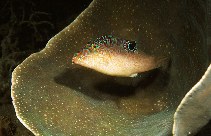| Family: |
Tetraodontidae (Puffers), subfamily: Canthigasterinae |
| Max. size: |
12 cm SL (male/unsexed) |
| Environment: |
reef-associated; brackish; marine; depth range 2 - 25 m, non-migratory |
| Distribution: |
Western Pacific: Philippines to the Solomon Islands, north to Ryukyu Islands and southern Marianas, south to Vanuatu. |
| Diagnosis: |
Dorsal spines (total): 0-0; Dorsal soft rays (total): 8-10; Anal spines: 0-0; Anal soft rays: 8-9. Caudal fin with a series of faint, narrow undulating lines (Ref. 559).
Description: Characterized further by brownish color with combination of fine blue to white lines and white spots on head and body; dorsal fin base with blue or green-edged black spot; yellowish tail, blue-barred; depth of body at origin of anal fin 2.4-3.1 in SL; head length 2.4-2.6 in SL; snout length 1.4-1.6 in head length; bony interorbital width 2.9-3.8 in head length; caudal peduncle depth 2.0-2.4 in head length; slightly rounded caudal fin (Ref. 90102). |
| Biology: |
Inhabits sandy areas of shallow lagoons and channels (Ref. 9710, 48637). Also found in silty bays or harbors around wharf pilings. Adults usually in pairs (Ref. 48637). |
| IUCN Red List Status: |
Least Concern (LC); Date assessed: 08 June 2011 Ref. (130435)
|
| Threat to humans: |
harmless |
Source and more info: www.fishbase.org. For personal, classroom, and other internal use only. Not for publication.
